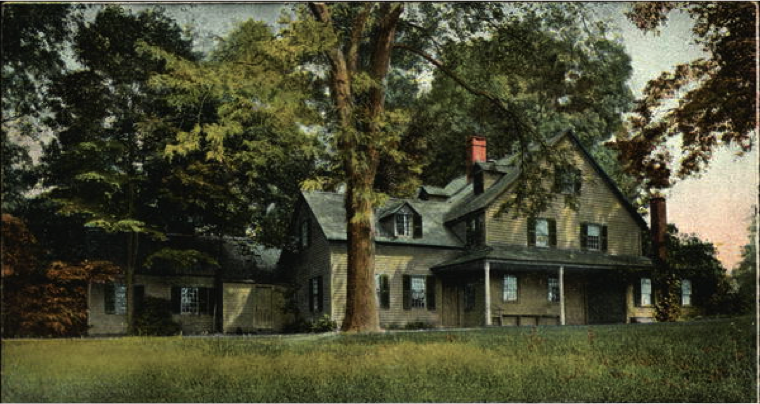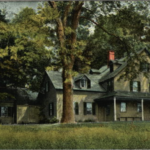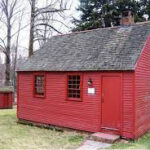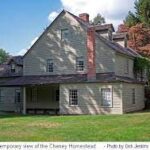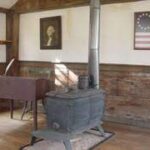HOURS/INFO
UPCOMING EVENTS
The Cheney Homestead at 106 Hartford Road, Manchester, Connecticut (860-647-9983), is owned and operated by the Historical Society. Usually open 1:00 to 4:00 on the second Sunday of each month except holidays, and also by appointment and for special events.
CHENEY HOMESTEAD
Timothy Cheney, farmer, miller and one of America’s famous clock makers, built the Cheney Homestead about 1785. A brook to the south of the home afforded water for the grist mill which he operated with his son George.
On October 25, 1798, George Cheney brought his bride, Electa Woodbridge Cheney, to the Homestead to “keep house.” To the couple were born eight sons and one daughter. With the exception of George Wells who died young, and Seth and John who became well-known artists, the brothers joined in establishing the Mt. Nebo Silk Company. The firm later incorporated as Cheney Brothers and became world famous as a leader in the silk industry.
In the Homestead, the downstairs living room was originally a pine-paneled keeping room with a massive fireplace and Dutch oven. The entrance door is extra wide so “hogsheads could be rolled into the buttery at the rear.” A unique feature of this room is the built-in wall clock. When a door from the southeast room was cut into the stairway, it was necessary to remove the clockworks. A picture of Lake Pepin by Seth Cheney replaces theface. The tall clock in this room is an example of Timothy’s work and is labeled.
To the east is a study which was originally an 8½ x 12½ ft. bedroom in which the children of George and Electa were born. Seth Cheney, who traveled and studied extensively abroad, came home one summer and enlarged this room for his mother, doing all the work himself.
An addition to the original house to the west provided a dormitory for the boys, now furnished as a dining room. Here are to be seen a set of Chippendale-style chairs which are attributed to Eliphalet Chapin of East Windsor.
As the Homestead is set into a hillside, the “second floor” is also on ground level with the “front” door of the paneled parlor facing east. An early 19th century chaise lounge with Chippendale back, a cage-top tilt table and a secretary with candle slides are features to look for. To the south of the stairs is one of the guest bedrooms and to the west of the parlor is a second bedroom.
Originally a bedroom, the last room to be added to the home has been furnished as a nursery with a spindle crib and a late 19th century doll house, all used by Cheney families.
Much of the fine 18th Century furniture was acquired in Philadelphia by John Cheney, the brother who was a famous engraver. Numerous drawings by Seth as well as etchings and engravings are to be seen throughout the home.
The Cheney Homestead at 106 Hartford Road, Manchester, Connecticut (860-647-9983), is owned and operated by the Historical Society. Usually open 1:00 to 4:00 on the second Sunday of each month except holidays, and also by appointment and for special events.
For additional historical information on the Cheney Homestead, click here to read an article in the “Reprints” section of this web site.
KEENEY SCHOOLHOUSE
Public schools in colonial Connecticut were operated by the Colony’s official, established church, which we now call “Congregational.” The legal institution which managed them was the ecclesiastical society. Qualified voters who belonged to the official church were members of this society.
In 1694, the General Court of the Connecticut Colony chartered an ecclesiastical society in the part of Hartford lying east of the “Great River,” consisting of East Hartford and the area called the Five Miles, which later became Orford Parish and still later the Town of Manchester.
In 1745, that Society gave the people in the Hop Brook section, Manchester’s first settlement, the right to conduct a school. In 1751, the Society authorized the erection of five schools in the Five Miles, all to be built without cost to the Society. The Society, however, would provide money for operating them.
There is little documentation about the schools erected under this grant. The story is that residents of the Hop Brook area built theirs in one day, using lumber measured and cut in anticipation of the grant. Probably the other four were built shortly thereafter.
Our one-room schoolhouse was originally built on Keeney Street about 1751. We are not certain when it ceased to be used as a school, was sold, and converted to a farm building.
In March 1975, the Town’s Bicentennial Committee voted to restore the building and to use a site on Cheney Homestead grounds. The Manchester Historical Society agreed to furnish and equip the building.
By 1975, however, the building had deteriorated so badly that it was not possible to restore it. A replica would have to be built. Volunteer workers dismantled the old structure, saving every usable piece of lumber. Fortunately, in the usable material were a few of the plank joists, shaped by hand to a graceful curve. Fastened to these were laths holding the curved plaster ceiling. Curved ceilings were not unusual in larger buildings of the 18th century, but few rural schoolhouses had them. New joists were cut to make the new ceiling.
The old building’s framing showed that a fireplace was originally used for heat. Woodburning stoves had replaced fireplaces in many old schools and it was decided to use such a stove in this replica. The furnishings are antiques and reproductions of the types which might have been found in the old schoolhouse.
The very small size of the classroom may surprise many visitors. The small size is accounted for by the fact that travel was very difficult in early Connecticut. Roads were incredibly bad. Bridges were rarities. It was impossible for small children to walk great distances, particularly in the snow of winter and the mud of spring. With the large families of the old days, a village of only a few houses or a small area of scattered farms required its own school.
All labor on this replica was done by unpaid volunteers*, whose service is here gratefully acknowledged. Many gifts of materials, furniture, books and equipment have assisted in the work. One special donation was a remarkable achievement — the pupils of the modern Keeney Elementary School raised $1,821 for furnishing and equipping this replica of the first school in their area.
The Keeney Schoolhouse, at 106 Hartford Road, Manchester, Connecticut, is generally open at the same time as the Cheney Homestead, the second Sunday of the month from 1 to 4, and by appointment and for special events. Donations are welcome. Phone 860-647-9983 for more information about tours.

